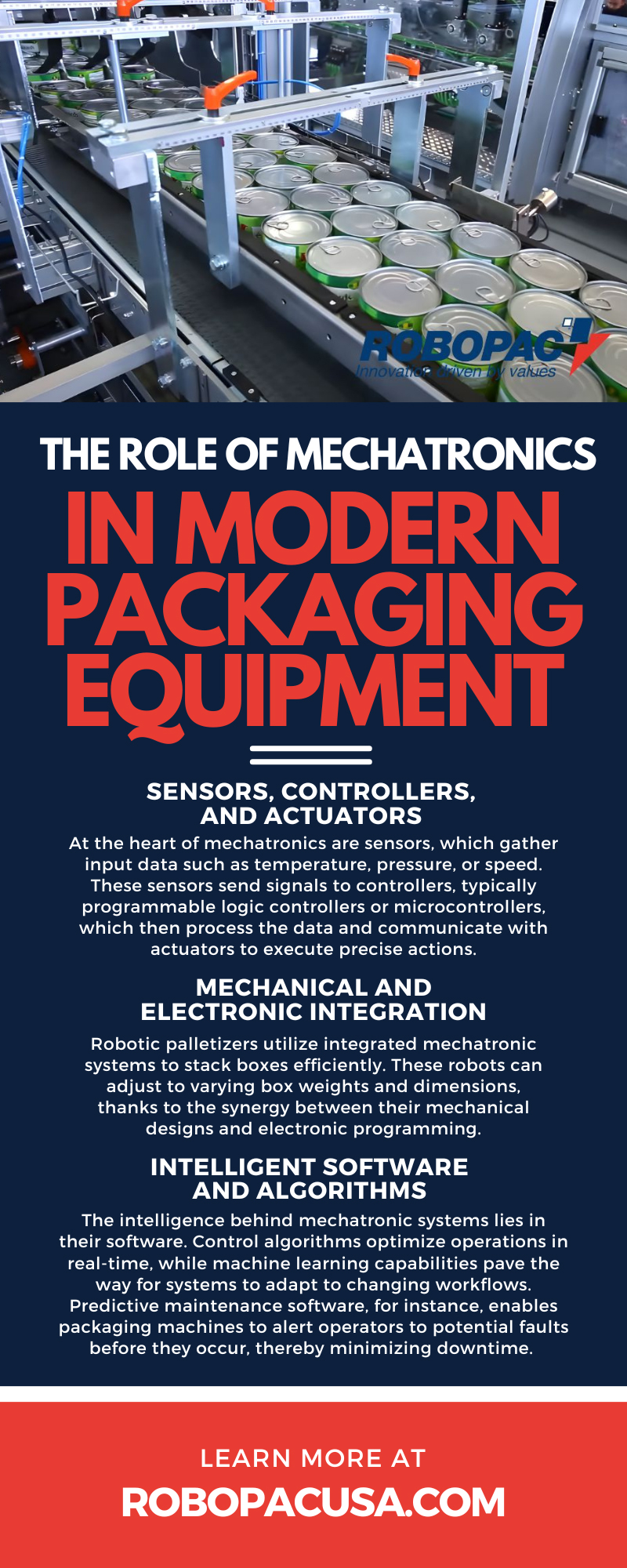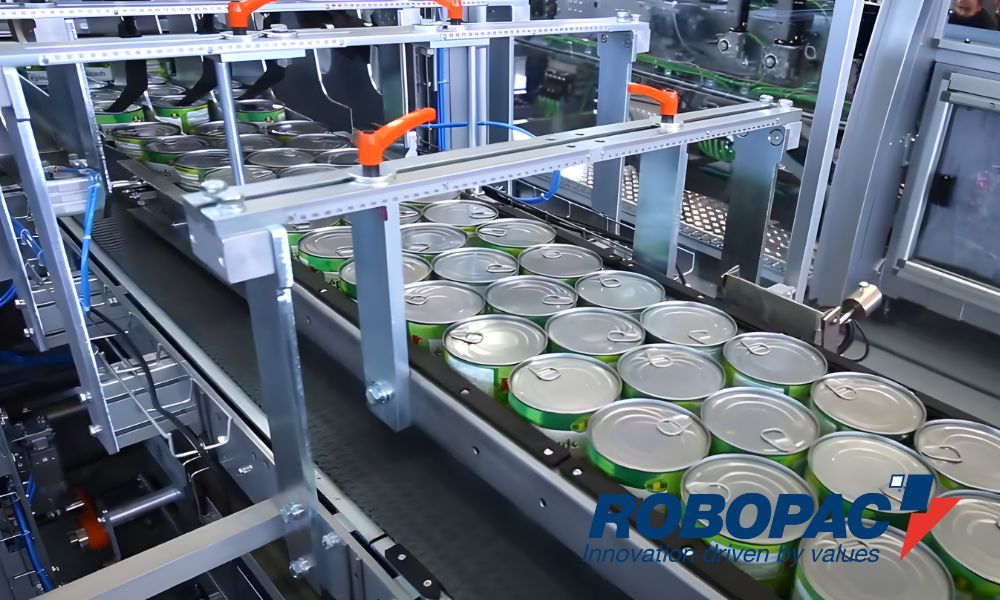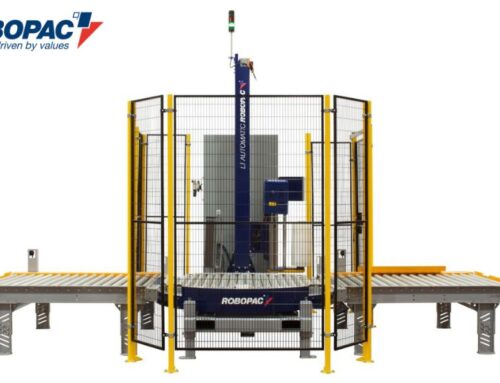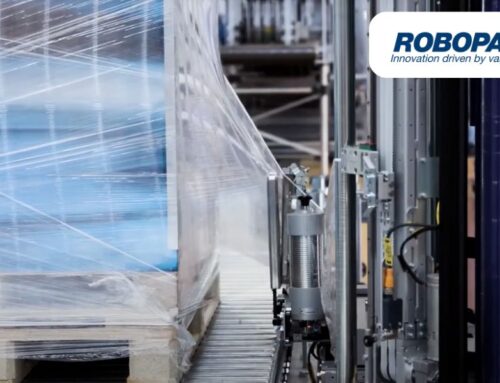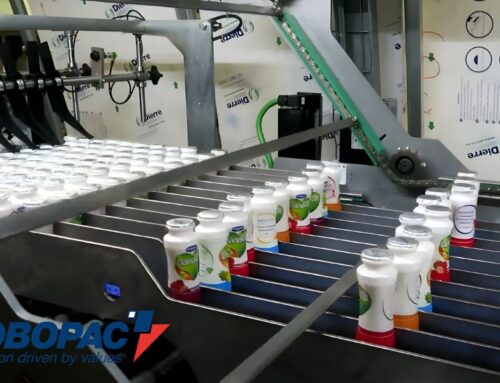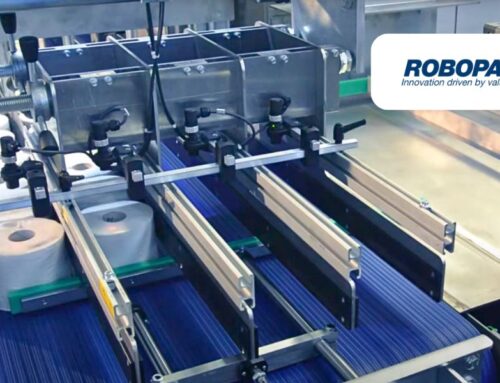In today’s fast-paced manufacturing world, mechatronics plays a pivotal role in revolutionizing packaging equipment by seamlessly integrating mechanical systems, electronics, and intelligent control to enhance efficiency, precision, and adaptability.
From sealing machines to quality control systems, this interdisciplinary approach is reshaping modern packaging equipment. In this guide, we’ll delve deeper into mechatronics and its role in modern packaging equipment, including its components, benefits in packaging, and more.
The Role of Mechatronics in Packaging
Mechatronics combines mechanical, electronic, and computational systems to create highly functional machines. First coined in 1969 by engineer Tetsuro Mori at Yaskawa Electric Corporation, it originated as a design philosophy that integrated mechanics and electronics rather than treating them separately. Today, mechatronics is essential in industries like automotive, manufacturing, and packaging.
In packaging, the growing complexity of machinery relies on technologies like programmable controllers, sensors, and advanced software for optimization. High-speed labeling machines, for instance, integrate robotic arms, dynamic servo motors, and labeling applicators, all synchronized with precise algorithms for flawless operation.
Components and Technologies
Modern mechatronic systems rely on a harmonious blend of hardware and software components for greater efficiency and flexibility. The vital components and technologies of modern mechatronics include sensors, integration of mechanical and electronic systems, and intelligent software.
Sensors, Controllers, and Actuators
At the heart of mechatronics are sensors, which gather input data such as temperature, pressure, or speed. These sensors send signals to controllers, typically programmable logic controllers or microcontrollers, which then process the data and communicate with actuators to execute precise actions.
For example, in a filling machine for beverages, sensors detect the positioning of bottles, controllers measure the desired quantity, and actuators execute the filling with precision, minimizing spillage and waste.
Mechanical and Electronic Integration
Unlike traditional machinery design, where mechanical and electrical systems function independently, mechatronics integrates these components seamlessly. Packaging systems can now multitask, such as sorting, sealing, and labeling, within a compact footprint.
For instance, robotic palletizers utilize integrated mechatronic systems to stack boxes efficiently. These robots can adjust to varying box weights and dimensions, thanks to the synergy between their mechanical designs and electronic programming.
Intelligent Software and Algorithms
The intelligence behind mechatronic systems lies in their software. Control algorithms optimize operations in real-time, while machine learning capabilities pave the way for systems to adapt to changing workflows. Predictive maintenance software, for instance, enables packaging machines to alert operators to potential faults before they occur, thereby minimizing downtime.
Benefits of Mechatronics in Packaging
Now that we have a better understanding of the important role of mechatronics in modern packaging equipment, we can look at the benefits it provides to the industry. The advantages of mechatronics for packaging include increased efficiency, enhanced accuracy, and greater process flexibility.
Enhanced Efficiency and Productivity
One of the most significant advantages of mechatronics is its ability to handle high-speed tasks with incredible accuracy. High-speed wrapping machines, for instance, can now pack hundreds of products per minute while maintaining consistent quality standards. This level of automation reduces the need for manual intervention, streamlining production processes and eliminating bottlenecks.
As a result, businesses in high-demand industries like food, beverage, and consumer goods can meet tight deadlines while staying competitive in the market. This boost in throughput increases productivity and allows companies to scale operations more effectively.
Improved Accuracy and Quality
When integrated with precision technologies like vision systems, advanced sensors, and robotic arms, mechatronic machinery can achieve unparalleled accuracy in tasks that require meticulous attention to detail. For example, applying labels to products in perfect alignment, precisely measuring and dispensing contents, or certifying airtight seals during packaging processes are all possible through these advanced systems.
This accuracy reduces the risk of human error and quality control rejections, leading to higher product quality. By adhering to strict quality control standards, mechatronics helps reinforce brand trust and customer satisfaction.
Flexibility and Adaptability
Mechatronics enhances the flexibility of packaging operations by enabling machines to handle many different product sizes, shapes, and materials with ease. For food and beverage packaging equipment, for example, modern case packing machines can seamlessly switch between packaging cartons, pouches, or bottles of varying sizes, making them invaluable for businesses with diverse product lines or seasonal variations.
This adaptability saves time and reduces the need for additional equipment, allowing manufacturers to respond quickly to changing consumer demands. The programmable nature of mechatronic systems also means that businesses can introduce new product configurations or packaging designs without extensive retooling.
Cost Savings and Reduced Waste
Mechatronics provides cost-saving opportunities by optimizing material usage and reducing waste. Technologies such as ultrasonic sealing, electronic gearing, and energy-efficient motors guarantee the handling of packaging materials as efficiently as possible, minimizing excess and lowering operational costs.
For example, ultrasonic sealing creates strong, reliable seals using less material than traditional methods, while electronic gearing improves synchronization between machine components, reducing wear and tear. The modular designs of many mechatronic systems also allow for easy upgrades and maintenance, extending the lifespan of equipment and reducing the need for costly replacements.
Applications of Mechatronics in the Industry
Mechatronics powers a wide array of equipment used in modern packaging facilities, enabling businesses to meet their operational goals efficiently. Sealing machines, labeling systems, and case packers all utilize mechatronics for greater efficiency and output quality.
Filling and Sealing Machines
These machines leverage integrated mechatronics to ensure the accurate filling of liquids, powders, or solids. Sensors detect product levels, while motors and controllers regulate operations for precise output. Ultrasonic sealing technology further reduces material waste by eliminating the need for additional sealing components like victim film.
Labeling and Coding Systems
Advanced labeling systems rely on mechatronics to position, align, and apply labels accurately to products moving through high-speed conveyors. Vision systems scan and validate the labels for alignment and compliance with regulatory requirements.
Palletizing and Case Packing Equipment
Robotic palletizers with advanced mechatronic systems have revolutionized end-of-line operations in modern manufacturing. By leveraging programmable algorithms, these systems can stack boxes with precision and uniformity, guaranteeing consistent pallet configurations. They are also highly adaptable, dynamically adjusting to changes in packaging formats, product sizes, and stacking patterns, which makes them ideal for diverse industries.
Case packing systems use a combination of sensors, grippers, and automated mechanisms to streamline the packing process. These systems efficiently handle delicate or irregularly shaped items, minimizing damage while maximizing packing speed and accuracy. Together, these technologies enhance productivity, reduce labor costs, and improve operational efficiency.
Inspection and Quality Control
Machine vision with mechatronic systems offers flawless inspection capabilities. These systems detect defects, contamination, or incorrect labeling in real time, thereby ensuring every product meets quality standards before it leaves the facility.
The Growing Impact of Mechatronics in Packaging
Mechatronics is transforming the packaging industry, integrating technologies to boost efficiency, enable predictive maintenance, and provide valuable data insights. Businesses adopting these advanced systems are preparing for a future where precision, flexibility, and sustainability are key. With its ever-evolving capabilities, mechatronics is set to revolutionize packaging, creating smarter and more adaptable solutions for the challenges ahead.
